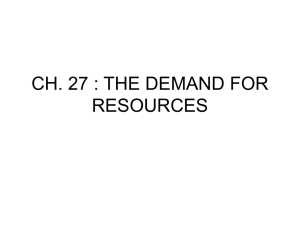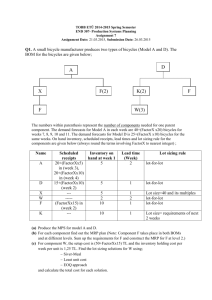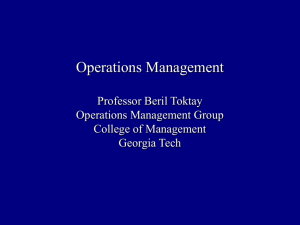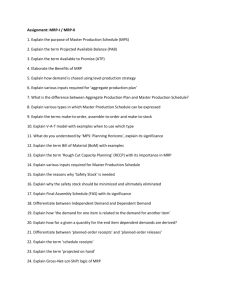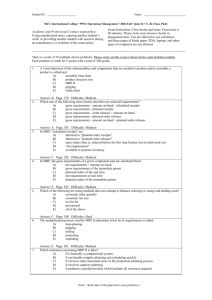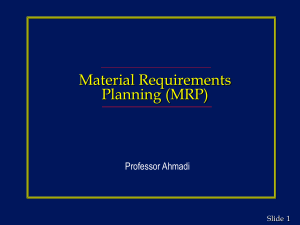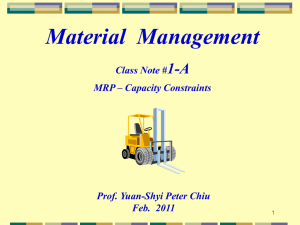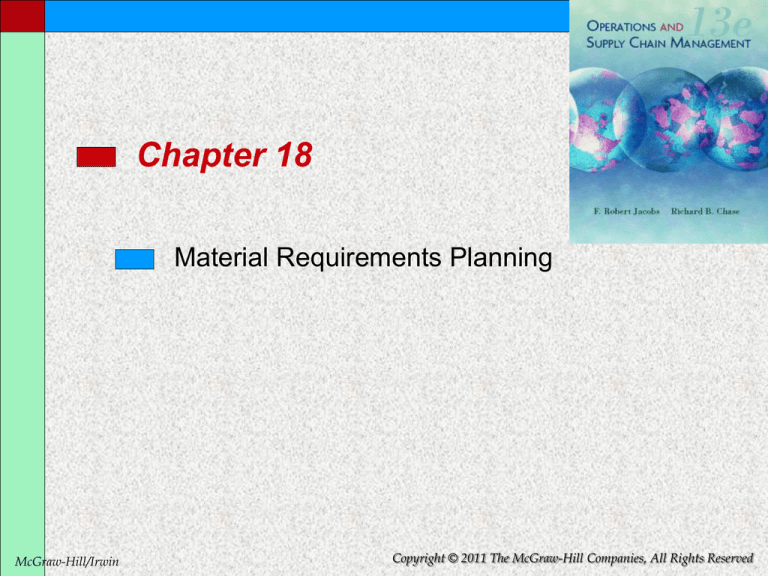
Chapter 18
Material Requirements Planning
McGraw-Hill/Irwin
Copyright © 2011 The McGraw-Hill Companies, All Rights Reserved
Learning Objectives
1. Describe what MRP is and where it is
best applied.
2. Understand the source of the
information used by the system.
3. Demonstrate how to do an MRP
“explosion.”
4. Explain how order quantities are
calculated in MRP systems.
18-2
Enterprise Resource Planning and
Material Requirements Planning
• Enterprise resource planning (ERP): a
computer system that integrates application
programs in accounting, sales, manufacturing,
and the other functions in a firm
• Materials requirements planning (MRP): a
means for determining the number of parts,
components, and materials needed to
produce a product
– MRP provides time scheduling information
specifying when each of the materials, parts, and
components should be ordered or produced
– Dependent demand drives MRP
LO 1
18-3
Master Production Scheduling
• The master schedule deals with end items
and is a major input to the MRP process
• All production systems have limited capacity
and limited resources
– The aggregate plan provides the general range of
operation, the master scheduler must specify
exactly what is to be produced
• To determine an acceptable feasible schedule
to be released to the shop, trial master
production schedules are run through the
MRP program
LO 1
18-4
Demand for Products
1. Customers who have placed specific
orders
– Generated by sales personnel
– Orders carry promised delivery dates
– No forecasting of these orders
2. Forecasted demand
– Normal independent-demand sales
3. Demand for parts and components
– Spares and repair
LO 2
18-5
Bill of Materials
• Bill of materials (BOM): contains the
complete product description, listing the
materials, parts, and components along
with the sequence in which the product
is created
– One of the three main inputs to the MRP
program
• Often called the product structure file or
product tree because it shows how a
product is put together
LO 2
18-6
MRP Computer Program
• MRP program uses information from:
– Inventory records
– Master schedule
– Bill of materials
• Process of calculating exact
requirements for each item is referred
to as the explosion process
– Work from top level down in BoM
– Consider on-hand balances and scheduled
orders
LO 2
18-7
MRP Explosion Process
1. The requirements for end items are
retrieved from the master schedule
•
These are referred to as “gross
requirements” by the MRP program
2. Uses on-hand balance with schedule
of orders to calculate the “net
requirements”
3. Using net requirements, it calculates
when orders should be received to
meet these requirements
LO 3
18-8
MRP Explosion Process Continued
4. Find a schedule for when orders are actually
released
•
To account for lead time
5. Move to level 1 items
6. Gross requirements for each level 1 item are
calculated from the planned-order release
schedule for the parents of each level 1 item
7. Net requirements, planned-order receipts,
and planned-order releases are calculated
as described in steps 2–4
8. Repeat for all items in bill of materials
LO 3
18-9
Economic Order Quantity
• Calculate reorder quantity based on
EOQ
• EOQ was not designed for a system
with discrete time periods such as MRP
• The lot sizes generated by EOQ do not
always cover the entire number of
periods
LO 4
18-10
Least Total Cost
• Least total cost method (LTC): a
dynamic lot-sizing technique that
calculates the order quantity by
comparing the carrying cost and the
setup costs for various lot sizes and
then selects the lot in which these are
most nearly equal
• Influenced by the length of the planning
horizon
LO 4
18-11
Least Unit Cost
• Least unit cost method: a dynamic
lot-sizing technique that adds ordering
and inventory carrying cost for each
trial lot size and divides by the number
of units in each lot size, picking the lot
size with the lowest unit cost
LO 4
18-12

